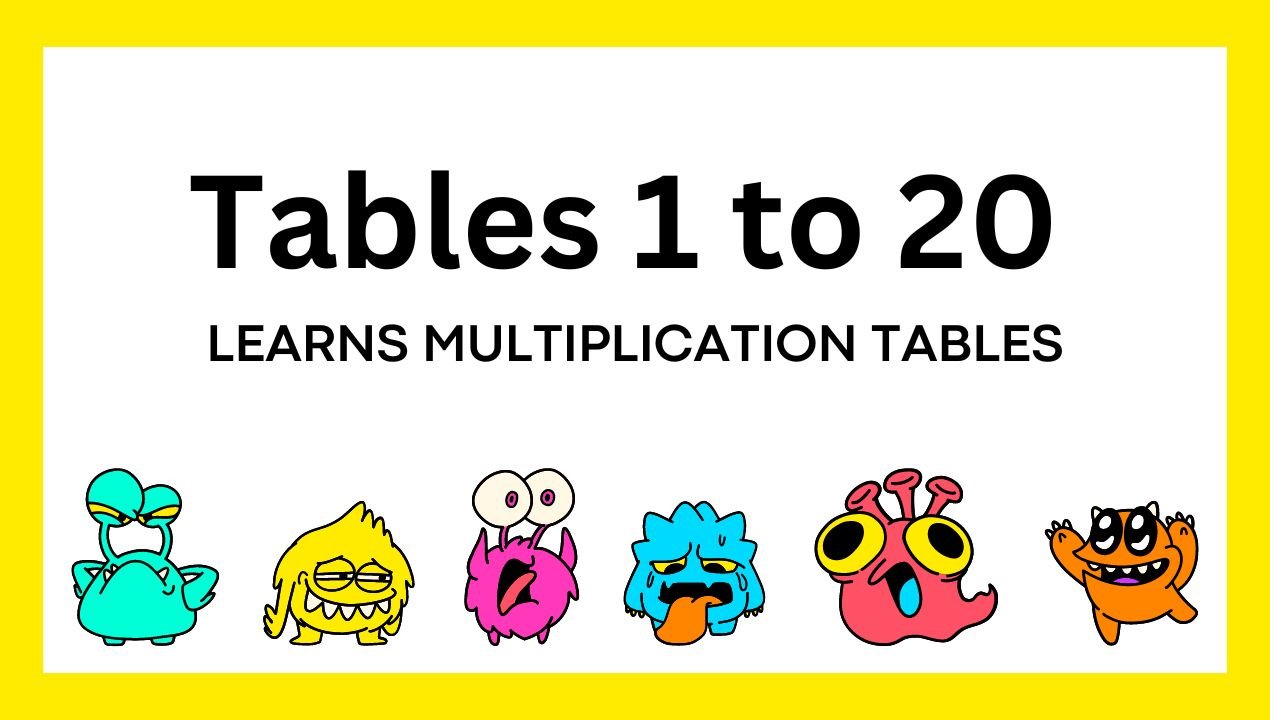Tables 1 to 20 help you figure out how numbers add up once you repeat them. They show you how easy it is when you take one number and add it to another number. Learning these tables makes math less complicated and faster, whether you’re checking things, understanding numbers, or doing traditional math
How would you Describe Table
A timetable is a neat arrangement that shows what you need to do and when. It records tasks or events within the arrangement, often with their due date. For outline, a school timetable can show the times for each course throughout the day. It helps people stay regular and not overlook basic things beyond any question.
Tables up to 20
Duplication charts up to 20 are charts that appear when replicating numbers from Tables 1 to 20 into each other. For illustration, 2 times 3 gives rise to 6 and 4 times 5 gives rise to 20. Each number from Tables 1 to 20 has its own set of increases.These make it easy to quickly find the answer to any increment problem within this run. They are helpful for learning and practising basic math.
Table up to 5
After you start the Table up to 5, you may want to start counting them in bunches together. For example, counting any number 1 time is the same number. Counting 2 times is like repeating the number. Counting 3 times is counting the number three times, e.g. 3 times 2 = 6. Counting 1 – 4 times is counting it four times, so 4 times 3 = 12. Finally, counting 5 times is like counting in fives, so 5 times 5 = 25. This way, you’ll easily be able to figure out what goes where!
| Table 1 | Table 2 | Table 3 | Table 4 | Table 5 |
| 1 × 1 = 11 × 2 = 21 × 3 = 31 × 4 = 41 × 5 = 51 × 6 = 61 × 7 = 71 × 8 = 81 × 9 = 91 × 10 = 10 | 2 × 1 = 22 × 2 = 42 × 3 = 62 × 4 = 82 × 5 = 102 × 6 = 122 × 7 = 142 × 8 = 162 × 9 = 182 × 10 = 20 | 3 × 1 = 33 × 2 = 63 × 3 = 93 × 4 = 123 × 5 = 153 × 6 = 183 × 7 = 213 × 8 = 243 × 9 = 273 × 10 = 30 | 4 × 1 = 44 × 2 = 84 × 3 = 124 × 4 = 164 × 5 = 204 × 6 = 244 × 7 = 284 × 8 = 324 × 9 = 364 × 10 = 40 | 5 × 1 = 55 × 2 = 105 × 3 = 155 × 4 = 205 × 5 = 255 × 6 = 305 × 7 = 355 × 8 = 405 × 9 = 455 × 10 = 50 |
Table 6 to 10
6 to 10 multiplication Table help you quickly find sums by counting numbers in groups. For example, increasing a number by 6 implies checking that number six times. These tables make it easier to understand problems and solve math quickly by showing you schemes about combining numbers.
| Table 6 | Table 7 | Table 8 | Table 9 | Table 10 |
| 6 x 1 = 6 6 x 2 = 12 6 x 3 = 18 6 x 4 = 246 x 5 = 30 6 x 6 = 366 x 7 = 426 x 8 = 486 x 9 = 546 x 10 = 60 | 7 x 1 = 77 x 2 = 147 x 3 = 217 x 4 = 287 x 5 = 357 x 6 = 427 x 7 = 497 x 8 = 567 x 9 = 637 x 10 = 70 | 8 × 1 = 88 × 2 = 168 × 3 = 248 × 4 = 328 × 5 = 408 × 6 = 488 × 7 = 568 × 8 = 648 × 9 = 728 × 10 = 80 | 9 × 1 = 99 × 2 = 189 × 3 = 279 × 4 = 369 × 5 = 459 × 6 = 549 × 7 = 639 × 8 = 729 × 9 = 819 × 10 = 90 | 10 × 1 = 1010 × 2 = 2010 × 3 = 3010 × 4 = 4010 × 5 = 5010 × 6 = 6010 × 7 = 7010 × 8 = 8010 × 9 = 9010 × 10 = 100 |
Table 11 to 15
Table up to 15 alludes to a set of charts appearing the comes about of increasing numbers from 1 to 15. Each chart records the occurrence of increasing one number by another, such as how 2 times 1 increments to 2, how 2 times 2 increments to 4, and so on up to 2 times 15. In expansion you have got charts for numbers from 3 to 15.This creates a comparison that you can easily find and know the results of multiplying numbers up to 15.
| Table 11 | Table 12 | Table 13 | Table 14 | Table 15 |
| 11 × 1 = 1111 × 2 = 2211 × 3 = 3311 × 4 = 4411 × 5 = 5511 × 6 = 6611 × 7 = 7711 × 8 = 8811 × 9 = 9911 × 10 =110 | 12 × 1 = 1212 × 2 = 2412 × 3 = 3612 × 4 = 4812 × 5 = 6012 × 6 = 7212 × 7 = 8412 × 8 = 9612 × 9 = 10812 × 10 = 120 | 13 × 1 = 1313 × 2 = 2613 × 3 = 3913 × 4 = 5213 × 5 = 6513 × 6 = 7813 × 7 = 9113 × 8 = 10413 × 9 = 11713 × 10 = 130 | 14 × 1 = 1414 × 2 = 2814 × 3 = 4214 × 4 = 5614 × 5 = 7014 × 6 = 8414 × 7 = 9814 × 8 = 11214 × 9 = 12614 × 10 = 140 | 15 × 1 = 1515 × 2 = 3015 × 3 = 4515 × 4 = 6015 × 5 = 7515 × 6 = 9015 × 7 = 10515 × 8 = 12015 × 9 = 13515 × 10 = 150 |
Table 16 to 20
Table up to 20 alludes to a set of charts appearing proportions of expanding numbers from 1 to 20. Each chart appears how one number includes up to others from 1 to 20, such as 3 times 4 includes up to 12, or 8 times 15 includes up to 120. It provides a comparison for quickly finding and obtaining multiplications for numbers up to 20.
| Table 16 | Table 17 | Table 18 | Table 19 | Table 20 |
| 16 × 1 = 1616 × 2 = 3216 × 3 = 4816 × 4 = 6416 × 5 = 8016 × 6 = 9616 × 7 = 11216 × 8 = 12816 × 9 = 14416 × 10 = 160 | 17 × 1 = 1717 × 2 = 3417 × 3 = 5117 × 4 = 6817 × 5 = 8517 × 6 = 10217 × 7 = 11917 × 8 = 13617 × 9 = 15317 × 10 = 170 | 18 × 1 = 1818 × 2 = 3618 × 3 = 5418 × 4 = 7218 × 5 = 9018 × 6 = 10818 × 7 = 12618 × 8 = 14418 × 9 = 16218 × 10 = 180 | 19 × 1 = 1919 × 2 = 3819 × 3 = 5719 × 4 = 7619 × 5 = 9519 × 6 = 11419 × 7 = 13319 × 8 = 15219 × 9 = 17119 × 10 = 190 | 20 × 1 = 2020 × 2 = 4020 × 3 = 6020 × 4 = 8020 × 5 = 10020 × 6 = 12020 × 7 = 14020 × 8 = 16020 × 9 = 18020 × 10 = 200 |
Conclusion
Repeating from 1 gives you the same number. Repeating a number 2 times doubles the number. 3 times means counting the number three times. 4 times is like counting four times. As you progress, 5 times is counting by five, 10 times by ten and 20 times by twenty. Each repetition continues counting the appropriate number more times, making it easy to quickly count to the full number for numbers from 1 to 20!
FAQs
1.What is the easiest way to remember the Table?
Sharpening makes a difference! Also, taking a note plan, such as how the 10 times list closes into zero 10, 20, 30, can make it less complicated.
2.How do I utilize the Table in genuine life?
You employ Table after you got to do a parcel of things, like checking cash, or figuring out how much of something you have got.
Read Also:- TWStalker: A Deep Dive into the Popular Twitter Viewer



